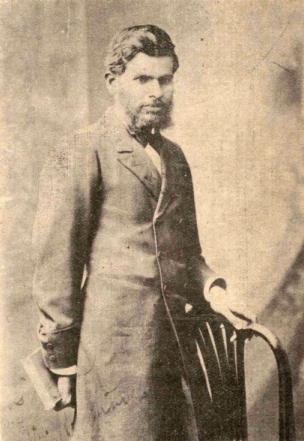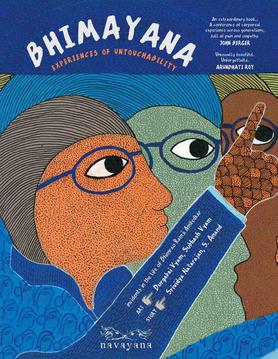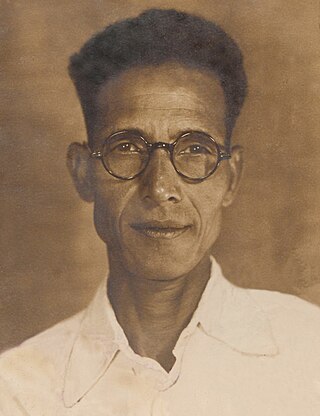
Bhimrao Ramji Ambedkar was an Indian jurist, economist, social reformer and political leader who headed the committee drafting the Constitution of India from the Constituent Assembly debates, served as Law and Justice minister in the first cabinet of Jawaharlal Nehru, and inspired the Dalit Buddhist movement after renouncing Hinduism.

The Dalit Buddhist movement is a religious as well as a socio-political movement among Dalits in India which was started by B. R. Ambedkar. It re-interpreted Buddhism and created a new school of Buddhism called Navayana. The movement has sought to be a socially and politically engaged form of Buddhism.
Untouchability is a form of social institution that legitimises and enforces practices that are discriminatory, humiliating, exclusionary and exploitative against people belonging to certain social groups. Although comparable forms of discrimination are found all over the world, untouchability involving the caste system is largely unique to South Asia.

Bhalchandra Trimbak Ranadive, popularly known as BTR, was an Indian communist politician and trade union leader.

Dalit is a term first coined by the Indian social reformer Jyotirao Phule for untouchables and outcasts, who represented the lowest stratum of the castes in the Indian subcontinent. Dalits were excluded from the fourfold varna of the caste hierarchy and were seen as forming a fifth varna, also known by the name of Panchama. Several scholars have drawn parallels between Dalits and the Burakumin of Japan, the Baekjeong of Korea and the peasant class of the medieval European feudal system.
Chandraseniya Kayastha Prabhu (CKP) or historically and commonly known as Chandraseniya Prabhu or just Prabhu is a caste mainly found in Gujarat and Maharashtra. Historically, they made equally good warriors, statesmen as well as writers. They held the posts such as Deshpande and Gadkari according to the historian, B.R. Sunthankar, produced some of the best warriors in Maharashtrian history.

Mahad ( [məɦaːɖ]) is a city in Raigad district situated in the North Konkan region of Maharashtra state, India. It is located 108.5 km (67.4 mi) from District Headquarters Alibag, and 167 km (104 mi) from Mumbai. Mahad is known for Raigad Fort, the capital of the Maratha Empire in Shivaji Maharaj's era and the revolutionary Mahad Satyagraha launched by at Chavdar Tale in the wake of modern India.
Martin Macwan is a Dalit human rights activist in Gujarat, India.

Vitthal Ramji Shinde was a revered social reformer, researcher, writer, and proponent of anti-untouchability activism and religious unity in Maharashtra, India. He played a prominent role among liberal thinkers and reformists before India gained independence. Shinde is recognized for his tireless efforts in fighting against the practice of ‘untouchability’ and advocating for support and education for ‘untouchables,’ including Dalits.
Events in the year 1927 in India.

Dr. Babasaheb Ambedkar is a 2000 Indian English-Hindi bilingual feature film directed by Jabbar Patel. It stars Mammootty in the title role. The film tells the story of B. R. Ambedkar, known mainly for his contributions in the emancipation of the downtrodden and oppressed castes, and as a result, the oppressed classes in India and shaping the Constitution of India, as the chairman of the Drafting Committee of the Indian Constituent Assembly.

Urmila Pawar is an Indian writer and activist in the dalit and feminist movements in India and her works, all of which are written in Marathi language, have often been hailed as a critique of social discrimination and the savarna exploitation by commentators and media outlets.

Bhimayana: Incidents in the Life of Bhimrao Ramji Ambedkar is a graphic biography of Bhimrao Ramji Ambedkar published in 2011 by Navayana and was hailed by CNN as being among the top five political comic books. It was created by artists Durgabai Vyam, Subhash Vyam and writers Srividya Natarajan and S. Anand. It depicts the experiences of caste discrimination and resistance that Bhimrao Ambedkar recorded in his autobiographical illustrations, later compiled and edited in Babasaheb Ambedkar: Writings and Speeches by Vasant Moon under the title “Waiting for a Visa”. It is one of India's top selling graphic books.

Ramchandra Babaji More was a political leader and campaigner with a particular focus around the struggle against the Caste system in India and Class exploitation in the Indian subcontinent.
Gangadhar Nilkanth Sahasrabuddhe was an Indian social activist from Maharashtra. He was born in a Marathi Chitpawan Brahmin family and belonged to the Social Service League. Along with other activists - Surendranath Tipnis, chairman of the Mahad Municipality and A.V. Chitre, he was instrumental in helping Babasaheb Ambedkar during the Mahad Satyagraha. During the satyagraha he burnt the book Manusmriti. Later, he went on to become the editor of Ambedkar's weekly 'Janata'.
Surendranath Tipnis was the president of the Mahad Municipality in the early 1900s and a social activist. He was born in a CKP family. Along with other progressive social activists of the time such as A.V. Chitre and the Chitpawan Brahmin G. N. Sahasrabudhe, he was instrumental in helping Babasaheb Ambedkar during the Mahad Satyagraha. He declared Mahad's public spaces open to untouchables and invited Ambedkar to hold a meeting at Mahad in 1927. Later, he went on to become an MLA in Ambedkar's Independent Labour Party. He was awarded the titles 'Dalitmitra'(friend of the dalits) and 'Nanasaheb'.

Ambedkarism is called as the teaching, ideology or philosophy of B.R. Ambedkar, an Indian economist, barrister, social reformer, and the first of Minister of Law and Justice in the first cabinet of Jawaharlal Nehru. Ambedkarism includes special focus on subjects such as fraternity, democracy, communal electorates, conversion out of Hinduism, political power, rule of law, Navayana, among others. An Ambedkarite is one who follows the philosophy of Ambedkar. Icons of Ambedkarite ideology also include Periyar, Jyotirao Phule and others.
Dinkarrao Javalkar was a social activist and a leader of non-Brahmin movement in Bombay Presidency. He, along with Keshavrao Jedhe, first emerged as a young leader of non-Brahmin movement in Pune, and later gained state-wide reputation for his scathing critic of Bal Gangadhar Tilak and Vishnushastri Chiplunkar in his book Deshache Dushman. Started as a principled follower of Mahatma Phule, he further turned more towards communism and worked to bring communist principles together with teachings of Satyashodhak Samaj.

Rao Bahadur Sitaram Keshav Bole, also known as Babasaheb Bole (1869―1961) was an Indian reformer, activist, barrister and politician from Bombay. He was a member of the Bombay Legislative Council, who was known for his contributions towards the upliftment of mill workers in Bombay and the Bhandari community. He was an associate of B. R. Ambedkar. He founded the Kitte Bhandari Aikyavardhak Mandali, founded in 1890. Rao Bahadur SK Bole Road in Dadar, Mumbai, is named after him. The British government conferred him the title of Rao Bahadur.













